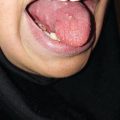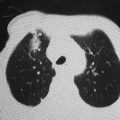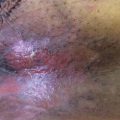, Ahmad Ameri1 and Mona Malekzadeh2
(1)
Department of Clinical Oncology, Imam Hossein Educational Hospital, Shahid Beheshti University of Medical Sciences (SBMU), Shahid Madani Street, Tehran, Iran
(2)
Department of Radiotherapy and Oncology, Shohadaye Tajrish Educational Hospital Shahid Beheshti University of Medical Sciences (SBMU), Tehran, Iran
Radiation cystitis is a complication of pelvic radiation therapy that patients encounter when treated for bladder cancer or other pelvic cancers.
There is a wide range of radiation cystitis incidence because of variation in radiation technique, time-dose-volume parameters, the subjective nature of the symptoms, and diversity in collecting and reporting patient data between studies that evaluated radiation cystitis [1].
Up to 70–90% of patients with bladder cancer experience acute genitourinary symptoms during radiation therapy [2–19]. Prostate cancer is the second most common reason for radiation-induced cystitis (41–100%) [20–30], followed by cervical cancer (20–25%) [31–35] and rectal cancer (35–53%) [36, 37].
16.1 Mechanism
The bladder wall has three well-defined layers including the mucosa (urothelium, basement membrane, and lamina propria), the muscularis propria, and the adventitia/serosa.
Human urothelium is considered a transitional epithelial tissue that its cellular differentiation increased from basal cells at basement membrane to surface cells of superficial or apical layer [38]. Surface cells known as umbrella cells are joined to each other with tight cell membrane junctions. The apical surface of umbrella cells is almost entirely covered by rigid plaques (known as the asymmetric unit membrane or AUM) consisting of a group of transmembrane proteins called uroplakins (UP), i.e., UPIa, UPIb, UPII, and UPIII [39–42].
Between these particles, UPIII is a main subunit of urothelial plaques that play a key role in urothelial structure [43].
The urothelium also contains a luminal negatively charged glycosaminoglycan (GAG) called a mucous layer that covers the umbrella cells on top of the apical membrane [44].
GAGs can be in a non-sulfated form like hyaluronic acid (HA) or a sulfated form like heparan sulfate and heparin, chondroitin sulfate (CS), dermatan sulfate, and keratan sulfate [45].
Tight junctions between umbrella cells, the urothelial plaques, and the glycosaminoglycan (GAG) layer make an efficient barrier against electrolyte and nonelectrolyte urine concentrations in bladder mucosa [46, 47].
Data on underlying mechanisms of acute radiation effects in the urinary bladder are limited. The urothelium barrier of the bladder is affected by radiation. Decrease in the number of umbrella cells [48], loss of the superficial UPIII layer [48], and GAG layer damage [49, 50] have been reported in patients with radiation cystitis. However, due to slow cell turnover rate of bladder epithelium (in the range of 42–350 days) [46, 51], gross tissue breakdown does not occur in early radiation cystitis [48].
Following the urothelium barrier impairment, urine substances infiltrate the bladder wall and produce more injuries by induction of the inflammatory response, mast cell proliferation, activation, degranulation and histamine release, vasodilatation, and also erythematous swelling [48]. Urine ion content, histamine, and other inflammatory substances irritate nerve terminals within the bladder wall [52]. This damaged barrier is also susceptible to secondary infection that could produce more injury [53].
16.2 Timing
The first symptoms of early radiation effects on the urinary bladder usually occur 4–6 weeks after treatment begins. They are usually mild and transient. It has been found that grade 2 or higher acute bladder toxicity may take an average of 6 weeks (range 2–21 weeks) after the completion of treatment to improve [55, 56], but 5–20% of patients may develop persistent late bladder damage from 6 months to 10 years after treatment [57]. The risk of late bladder damage depends on pre-radiation therapy genitourinary morbidity [4], smoking history (≥1 pack per day) [58], body mass index(>30 kg/m2) [58], any kind of procedure before radiation therapy [59], and a high dose per fraction [60] that go beyond the scope of this book.
16.3 Risk Factors
The risk of acute bladder damage increases with pre-radiation therapy genitourinary morbidity score [4, 61].
Chemotherapy administered concurrently with radiation therapy has not been shown to significantly increase the risk of acute bladder complications [12, 34, 62], whereas use of hormonal therapy in prostate cancer has been associated with more acute genitourinary complications [4, 61].
Radiation total dose, maximum bladder dose, and higher volume of bladder exposed to radiation are associated with a higher risk of acute toxicity [29, 63, 64]. The treatment time and dose per fraction have not been reported to be related with acute bladder injury [56, 65].
16.4 Symptoms and Diagnosis
Radiation cystitis symptoms during the early reaction phase include frequency, nocturia, urgency, dysuria, and hematuria [66].
Urgency: Sudden and compelling desire to pass urine, which is difficult to defer
Incontinence: Involuntary leakage of urine with the feeling of urgency
Frequency: Voiding more than eight times during the day
Nocturia: Need to wake up more than once at night to void
Bacterial infection may complicate the clinical picture.
Direct examination of the urothelium demonstrates mucosal edema, hyperemia, and inflammation.
16.5 Scoring
Radiation Therapy Oncology Group (RTOG) radiation induced bladder morbidity scoring criteria presented in Table 16.1 [67].
Table 16.1
RTOG bladder morbidity scoring
Grade 1 | Frequency of urination or nocturia twice pretreatment habit/dysuria, urgency not requiring medication |
Grade 2 | Frequency of urination or nocturia that is less frequent than every hour. Dysuria, urgency, and bladder spasm requiring local anesthetic (e.g., Pyridium) |
Grade 3 | Frequency with urgency and nocturia hourly or more frequency/dysuria, pelvis pain or bladder spasm requiring regular, frequent narcotic/gross hematuria with/without clot passage |
Grade 4 | Hematuria requiring transfusion/acute bladder obstruction not secondary to clot passage, ulceration, or necrosis |
16.6 Prevention
Acute symptoms of radiation injury to the bladder are usually self-limited and manageable [68], but prevention of these symptoms is important because they are associated with a marked impact on quality of life and increased occurrence of late toxicities [56].
16.6.1 Bladder Sparing
With the introduction of novel radiation therapy techniques like intensity-modulated radiation therapy (IMRT) or image-guided radiotherapy (IGRT), treatment conformity and normal tissue sparing improve, which minimize the risk of treatment-related toxicity. A significant reduction in acute bladder toxicity in prostate, cervical, and rectal cancer patients treated with this highly conformal treatment versus 3D conformal radiotherapy (3DCRT) has been found [69–73].
Different dose-volume parameters have been proposed to predict acute genitourinary toxicities. For example, maximum dose (Dmax) of bladder in prostate cancer study [29] and volume of bladder receiving 35 Gy or more in rectal cancer [36] have been reported to have significant correlations with the risk of acute bladder toxicity.
16.6.2 Intravesical Instillation
Intravesical GAG instillations including hyaluronic acid [73] and chondroitin sulfate [74] in patients undergoing radiation therapy may reduce overactive bladder symptoms due to covering of the bladder urothelium and preventing of cellular damage by urinary irritants.
The proposed treatment scheme of chondroitin sulfate is weekly instillations of 40 mL of 0.2% solution of chondroitin sulfate during radiation therapy in outpatient clinic after a course of radiation therapy (at least 2 days after chemotherapy). A single-use catheter is usually used to empty the bladder and then fill it with the 40 mL solution. Patients are asked not to void at least 2 h after the instillation [74].
The proposed treatment scheme of intravesical hyaluronic acid prescription is instillations of 40 mg/50 mL intravesical hyaluronic acid. Instillations should begin 1 week before starting radiation therapy and then weekly instillations until 4 weeks after completion of radiation therapy [73].
16.7 Management
Generally, all patients with acute radiation cystitis symptoms should be encouraged to increase fluid intake. It can result in urine irritant dilution and prevent urinary tract infections [75].
Acute radiation cystitis often responds to symptomatic therapy. Anticholinergics have been the mainstay of management for storage symptoms such as frequency. Other treatment options include analgesics like phenazopyridine and alpha-1 blocker [66].
16.7.1 Anticholinergics
Anticholinergic agents block acetylcholine effects at muscarinic receptors and suppress bladder muscle contractions [76]. These agents improve bladder storage and alleviate symptoms.
Oxybutynin and tolterodine are widely used for overactive bladder symptoms. They are nonspecific muscarinic receptor blocker and can cause side effects by acting on other parts of the body (e.g., dry mouth or eyes, constipation, or nausea). Oxybutynin and tolterodine appear to have similar effects on patients’ symptom improvement but have a lower risk of withdrawals and dry mouth [76, 77]. Extended release preparations of these drugs are available and are associated with similar efficacy and less risk of dry mouth [76, 77]. Hyoscyamine is another anticholinergic agent that is used to treat cystitis. Data for comparing hyoscyamine to other anticholinergic drugs are lacking.
16.7.2 Alpha-1 Blocker
Tamsulosin is an α-1A-specific blocker that induces selective relaxation of the detrusor muscle and improved bladder compliance [80]. Tamsulosin may be the preferred drug to prescribe over other apha-1 blockers like prazosin because of its more acceptable side effect profile and greater patient satisfaction [81].
Usage: 0.4 mg PO once daily, 30 min after same meal each day [82];
it should be used with caution in patients with coronary artery disease [82].
16.7.3 Analgesics
Phenazopyridine is a urinary analgesic that is excreted into the urine and induces a local analgesic effect.
Usage: 100–200 mg PO after meals three times daily [83].
Phenazopyridine is contraindicated in hypersensitivity to drug, severe hepatitis, and renal impairment (CrCl <50 mL/min) [83].
16.7.4 Intravesical GAG
Damage to the GAG layer has been found in radiation cystitis mechanism. Intravesical GAG could be bound to the damaged bladder surface and reduce radiation cystitis symptoms. The glycosaminoglycan molecule is not absorbed into the body and doesn’t penetrate the bladder and remain on the mucosal surface [84].
Extensive clinical experience has been gained with formulations containing either chondroitin sulfate, hyaluronic acid, or a combination of chondroitin sulfate and hyaluronic acid in late radiation cystitis [50]. More trials are needed to determine the benefit of these agents in acute radiation cystitis.
References
1.
Marks LB, Carroll PR, Dugan TC, Anscher MS (1995) The response of the urinary bladder, urethra, and ureter to radiation and chemotherapy. Int J Radiat Oncol Biol Phys 31(5):1257–1280PubMed
2.
Turgeon G-A, Souhami L, Cury FL, Faria SL, Duclos M, Sturgeon J et al (2014) Hypofractionated intensity modulated radiation therapy in combined modality treatment for bladder preservation in elderly patients with invasive bladder cancer. Int J Radiat Oncol Biol Phys 88(2):326–331PubMed
Stay updated, free articles. Join our Telegram channel

Full access? Get Clinical Tree






